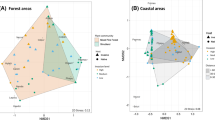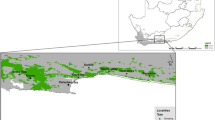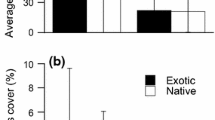Abstract
The high dependence of herbivorous insects on their host plants implies that plant invaders can affect these insects directly, by not providing a suitable habitat, or indirectly, by altering host plant availability. In this study, we sampled Asteraceae flower heads in cerrado remnants with varying levels of exotic grass invasion to evaluate whether invasive grasses have a direct effect on herbivore richness independent of the current disturbance level and host plant richness. By classifying herbivores according to the degree of host plant specialization, we also investigated whether invasive grasses reduce the uniqueness of the herbivorous assemblages. Herbivorous insect richness showed a unimodal relationship with invasive grass cover that was significantly explained only by way of the variation in host plant richness. The same result was found for polyphagous and oligophagous insects, but monophages showed a significant negative response to the intensity of the grass invasion that was independent of host plant richness. Our findings lend support to the hypothesis that the aggregate effect of invasive plants on herbivores tends to mirror the effects of invasive plants on host plants. In addition, exotic plants affect specialist insects differently from generalist insects; thus exotic plants affect not only the size but also the structural profile of herbivorous insect assemblages.




Similar content being viewed by others
References
Almeida AM, Fonseca CR, Prado PI, Almeida-Neto M, Diniz S, Kubota U, Braun MR, Raimundo RLG, Anjos LA, Mendonça TG, Futada SM, Lewinsohn TM (2005) Diversidade e ocorrência de Asteraceae em cerrados de São Paulo. Biota Neotrop 5:27–43
Almeida AM, Fonseca CR, Prado PI, Almeida-Neto M, Diniz S, Kubota U, Braun MR, Raimundo RLG, Anjos LA, Mendonça TG, Futada SM, Lewinsohn TM (2006) Assemblages of endophagous insects on Asteraceae in São Paulo cerrados. Neotrop Entomol 35:458–468
Almeida-Neto M, Prado PI, Kubota U, Bariani JM, Aguirre GH, Lewinsohn TM (2010) Invasive grasses and native Asteraceae in the Brazilian Cerrado. Plant Ecol 209:109–122
Arbuckle JL (2003) Amos user’s guide, 5.0 Update. Smallwaters, Chicago
Bartomeus I, Vilà M, Santamaría L (2008) Contrasting effects of invasive plants in plant-pollinator networks. Oecologia 155:761–770
Baruch Z, Ludlow MM, David R (1985) Photosynthetic responses of native and introduced C4 grasses from Venezuela savannas. Oecologia 67:388–393
Brändle M, Amarell U, Auge H, Klotz S, Brandl R (2001) Plant and insect diversity along a pollution gradient: understanding richness across trophic levels. Biodivers Conserv 10:1497–1511
Braun MR, Almeida-Neto M, Loyola RD, Prado AP, Lewinsohn TM (2008) New host-plant records for neotropical agromyzids (Diptera: Agromyzidae) from Asteraceae flower heads. Neotrop Entomol 37:97–99
Brooks ML, D’Antonio CM, Richardson DM et al (2004) Effects of invasive alien species on fire regimes. Bioscience 54:677–688
Brown JH (1984) On the relationship between abundance and distribution of species. Am Natur 124:255–279
Brown VK, Hyman PS (1986) Successional communities of plants and phytophagous Coleoptera. J Ecol 74:963–975
Burnham KP, Anderson DR (2002) Model selection and multimodel inference: a practical-theoretic approach, 2nd edn. Springer, New York
Charrette NA, Cleary DFR, Mooers AØ (2006) Range-restricted, specialist bornean butterflies are less likely to recover from enso-induced disturbance. Ecology 2330–2337
Davies KF, Margules CR, Lawrence JF (2004) A synergistic effect puts rare, specialized species at greater risk of extinction. Ecology 85:265–271
De Groot M, Kleijn D, Jogan N (2007) Species groups occupying different trophic levels respond differently to the invasion of semi-natural vegetation by Solidago canadensis. Biol Conserv 136:612–617
Didham RK, Tylianakis JM, Hutchison MA, Ewers RM, Gemmell NJ (2005) Are invasive species the drivers of ecological changes? Trends Ecol Evol 20:470–474
Durigan G, Siqueira MF, Franco GADC (2007) Threats to the Cerrado remnants of the state of São Paulo, Brazil. Sci Agric 64:355–363
Ehrenfeld JG (2003) Effects of exotic plant invasions on soil nutrient cycling processes. Ecosystems 6:503–523
Ernst CM, Cappuccino N (2005) The effect of an invasive alien vine, Vincetoxicum rossicum (Asclepiadaceae), on arthropod populations in Ontario old fields. Biol Invas 7:417–425
Filgueiras TS (2002) Herbaceous plant communities. In: Oliveira PS, Marquis RJ (eds) The Cerrados of Brazil: ecology and natural history of a Neotropical savanna. Columbia University Press, New York, pp 121–139
Fonseca CR, Prado PIK, Almeida-Neto M et al (2005) Flowerheads and their insects: food web structure along a fertility gradient of Cerrado. Ecol Entomol 30:36–46
Fournier LA (1974) Quantitative method for measuring phenological characteristics of trees. Turrialba 24:422–423
Gerber E, Krebs C, Murrell C, Moretti M, Rocklin R, Schaffner U (2008) Exotic invasive knotweeds (Fallopia spp.) negatively affect native plant and invertebrate assemblages in European riparian habitats. Biol Conserv 141:646–654
Grace JB (2006) Structural equation modeling and natural systems. Cambridge University Press, Cambridge
Grace JB, Keeley JE (2006) A structural equation model analysis of postfire plant diversity in California shrublands. Ecol Appl 16:503–514
Gratton C, Denno RF (2005) Restoration of arthropod assemblages in a Spartina salt marsh following removal of the invasive plant Phragmites australis. Restor Ecol 13:358–372
Haddad NM, Tilman D, Haarstad J, Ritchie M, Knops JMH (2001) Contrasting effects of plant richness and composition on insect communities: a field experiment. Am Nat 158:17–35
Hawkes CV, Wren IF, Herman DJ, Firestone MK (2005) Plant invasion alters nitrogen cycling by modifying the soil nitrifying community. Ecol Lett 8:976–985
Heleno RH, Ceia RS, Ramos JA, Memmott J (2008) Effects of alien plants on insect abundance and biomass: a food-web approach. Conserv Biol 23:410–419
Hobbs RJ, Huenneke LF (1992) Disturbance, diversity and invasion: implications for conservation. Conserv Biol 6:324–337
Hoffmann WA, Haridasan M (2008) The invasive grass, Melinis minutiflora, inhibits tree regeneration in a Neotropical savanna. Austral Ecol 32:29–36
Hoffmann WA, Lucatelli VMPC, Silva FJ, Azeuedo INC, Marinho MS, Albuquerque AMS, Lopes AO, Moreira SP (2004) Impact of the invasive alien grass Melinis minutiflora at the savanna-forest ecotone in the Brazilian Cerrado. Divers Distrib 10:99–103
Hughes JB (2000) The scale of resource specialization and the distribution and abundance of lycaenid butterflies. Oecologia 123:375–383
Hunter MD, Price PW (1992) Playing chutes and ladders: heterogeneity and the relative roles of bottom-up and top-down forces in natural communities. Ecology 73:724–732
Hutchinson GE (1959) Homage to Santa Rosalia, or why are there so many kinds of animals. Am Nat 93:145–159
Jonsen ID, Fahrig L (1997) Response of generalist and specialist insect herbivores to landscape spatial structure. Land Ecol 12:185–197
Kitahara M, Sei K, Fujii K (2000) Patterns in the structure of grassland butterfly communities along a gradient of human disturbance: further analysis based on the generalist/specialist concept. Popul Ecol 42:135–144
Klink CA (1996) Competition between the African grass Andropogon gayanus Kunth and the native cerrado grass Schizachyrium tenerum Nees. Rev Bras Bot 19:11–15
Koh LP, Sodhi NS, Brook BW (2004) Ecological correlates of extinction proneness in tropical butterflies. Conserv Biol 18:1571–1578
Köppen W (1948) Climatología. Fondo de Cultura Económica, México
Lawton JH (1993) Range, population abundance and conservation. Trends Ecol Evol 8:409–413
Leibold MA, Holyoak M, Mouquet N, Amarasekare P, Chase JM, Hoopes MF, Holt RD, Shurin JB, Law R, Tilman D, Loreau M, Gonzalez A (2004) The metacommunity concept: a framework for multiscale community ecology. Ecol Lett 7:601–613
Levine JM, Vilà M, D’Antonio CM, Dukes JS, Grigulis K, Lavorel S (2003) Mechanisms underlying the impacts of exotic plant invasions. Proc Biol Sci 270:775–781
Lewinsohn TM (1991) Insects in flower heads of Asteraceae in Southeast Brazil: a tropical case study on species richness. In: Price PW, Lewinsohn TM, Fernandes GW, Benson WW (eds) Plant-animal interactions: evolutionary ecology in tropical and temperate regions. Wiley/Interscience, New York, pp 525–560
Lewinsohn TM, Roslin T (2008) Four ways towards tropical herbivore megadiversity. Ecol Lett 11:398–416
Lewinsohn TM, Novotny V, Basset Y (2005) Insects on plants: diversity of herbivore assemblages revisited. Annu Rev Ecol Evol Syst 36:597–620
Litt AR, Steidl RJ (2010) Insect assemblages change along a gradient of invasion by a nonnative grass. Biol Invas 12:3449–3463
Lozon JD, MacIsaac HJ (1997) Biological invasions: are they dependent on disturbance? Environ Rev 5:131–144
MacDougall AS, Turkington R (2005) Are invasive species the drivers or passengers of change in degraded ecosystems? Ecology 86:42–55
Mack MC, D’Antonio CM (1998) Impacts of biological invasions on disturbance regimes. Trends Ecol Evol 13:195–198
Mack RN, Simberloff D, Lonsdale WM, Evans H, Clout M, Bazzaz FA (2000) Biotic invasions: causes, epidemiology, global consequences, and control. Ecol Appl 10:689–710
May RM (2000) The dimensions of life on earth. In: Raven PH, Williams T (eds) Nature and human society: the quest for a sustainable world. National Academy Press, Washington, pp 30–45
McKinney ML (1997) Extinction vulnerability and selectivity: combining ecological and paleontological views. Annu Rev Ecol Syst 28:495–516
McKinney ML, Lockwood JL (1999) Biotic homogenization: a few winners replacing many losers in the next mass extinction. Trends Ecol Evol 14:450–453
Millennium Ecosystem Assessment (MEA) (2005) Ecosystems and human well-being: synthesis. Island Press, Washington
Mistry J (1998) Fire in the cerrado (savannas) of Brazil: an ecological review. Progr Phys Geogr 22:425–448
Mistry J, Berardi A (2005) Assessing fire potential in a Brazilian savanna nature reserve. Biotropica 37:439–451
Mittermeier RA, Gil PR, Hoffmann M et al (eds) (2005) Hotspots revisited: earth’s biologically richest and most endangered terrestrial ecoregions. Conservation International, Washington
Murdoch WW, Peterson CH, Evans FC (1972) Diversity and pattern in plants and insects. Ecology 53:819–829
Novotny V, Miller SE, Hulcr J, Drew RAI, Basset Y, Janda M, Setliff GP, Darrow K, Stewart AJA, Auga J, Isua B, Molem K, Manumbor M, Tamtiai E, Mogia M, Weiblen GD (2007) Low beta diversity of herbivorous insects in tropical forests. Nature 448:692–695
Ødegaard F, Diserud OH, Østbye K (2005) The importance of plant relatedness for host utilization among phytophagous insects. Ecol Lett 8:612–617
Odum EP (1969) The strategy of ecosystem development. Science 164:262–270
Ortega YK, Pearson DE (2005) Weak vs. strong invaders of natural plant communities: assessing invasibility and impact. Ecol Appl 15:651–661
Pearson DE (2009) Invasive plant architecture alters trophic interactions by changing predator abundance and behavior. Oecologia 159:549–558
Pivello VR, Carvalho VCM, Lopes PF, Peccinini AA, Rosso S (1999a) Abundance and distribution of native and alien grasses in a “cerrado” Brazilian Savanna biological reserve. Biotropica 31:71–82
Pivello VR, Shida CN, Meirelles ST (1999b) Alien grasses in Brazilian savannas: a threat to the biodiversity. Biodivers Conserv 8:1281–1294
Pöyry J, Luoto M, Paukkunen J, Pykälä J, Raatikainen K, Kuussaari M (2006) Different responses of plants and herbivore insects to a gradient of vegetation height: an indicator of the vertebrate grazing intensity and successional age. Oikos 115:401–412
Prado H, Oliveira JB, Almeida CLA (1981) Levantamento pedológico semidetalhado do Estado de São Paulo: quadrícula de São Carlos Mapa escala 1:100.000
Prado PI, Almeida AM, Lewinsohn TM, Norrbom AL, Buys BD, Macedo AC, Lopes MB (2002) The fauna of Tephritidae (Diptera) from capitula of Asteraceae in Brazil. Proc Entomol Soc Wash 104:1006–1027
Quinn RM, Gaston KJ, Roy DB (1997) Coincidence between consumer and host occurrence: macrolepidoptera in Britain. Ecol Entomol 22:197–208
R Development Core Team (2006) R: a language and environment for statistical computing. R Foundation for Statistical Computing, Vienna, Austria. ISBN 3-900051-07-0, http://www.R-project.org
Ratter JA, Ribeiro JF, Bridgewater S (1997) The Brazilian cerrado vegetation and threats to its biodiversity. Ann Bot 80:223–230
Sano SM, Almeida SP, Ribeiro JF (2008) Cerrado: ecologia e flora, vol 2. Embrapa, Brasília
Siemann E, Tilman D, Haarstad J, Ritchie M (1998) Experimental tests of the dependence of arthropod diversity on plant diversity. Am Nat 152:738–750
Siemann E, Haarstad J, Tilman D (1999) Dynamics of plant and arthropod diversity during old field succession. Ecography 22:406–414
Southwood TRE, Brown VK, Reader PM (1979) The relationships of plant and insect diversity in succession. Biol J Linn Soc 12:327–348
Strong DR, Lawton JH, Southwood TRE (1984) Insects on plants. Blackwell, Oxford
Tallamy DW (2004) Do alien plants reduce insect biomass? Conserv Biol 18:1689–1692
Valtonen A, Jantunen J, Saarinen K (2006) Flora and lepidoptera fauna adversely affected by invasive Lupinus polyphyllus along road verges. Biol Conserv 133:389–396
Vitousek PM, Mooney HA, Lubchenco J, Melillo JM (1997) Human domination of earth’s ecosystems. Science 277:494–499
White R, Murray S, Rohweder M (2000) Pilot analysis of global ecosystems: grassland ecosystems technical report. World Resources Institute, Washington
Yoshioka A, Kadoya T, Suda S, Washitani I (2010) Impacts of weeping lovegrass (Eragrostis curvula) invasion on native grasshoppers: responses of habitat generalist and specialist species. Biol Invas 12:531–539
Zwölfer H (1988) Evolutionary and ecological relationships of the insect fauna of thistles. Annu Rev Entomol 33:103–122
Acknowledgments
We are grateful to various colleagues for their valuable help with field work, and to Marina R. Braun, Valéria C. Maia, Maria V. Urso-Guimarães, Sérgio Vanin, José R. Mermudes, João Semir, Roberto L. Esteves, and Mara Magenta for providing or confirming identification of insects and plants. This study is part of MAN’s PhD thesis presented to the Graduate Program in Ecology at UNICAMP, and was supported by FAPESP Grants # 98/05085-2 to T.M.L. within the BIOTA-FAPESP Program, # 04/15482-1 to T.M.L., # 03/02541-0 and 06/56889-2 to M.A.N., and CNPq Grants # 306049/2004 to T.M.L. and # 303878/2008-8 to P.I.P.
Author information
Authors and Affiliations
Corresponding author
Additional information
Communicated by Roland Brandl.
Electronic supplementary material
Below is the link to the electronic supplementary material.
Online Resource 1:
A table listing the species of flower head-feeding insects recorded in this study and their abundances. (DOC 124 kb)
Online Resource 2:
A list of the functions used in the model selection analyses. (DOC 51 kb)
Rights and permissions
About this article
Cite this article
Almeida-Neto, M., Prado, P.I. & Lewinsohn, T.M. Phytophagous insect fauna tracks host plant responses to exotic grass invasion. Oecologia 165, 1051–1062 (2011). https://doi.org/10.1007/s00442-010-1783-1
Received:
Accepted:
Published:
Issue Date:
DOI: https://doi.org/10.1007/s00442-010-1783-1




